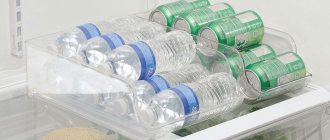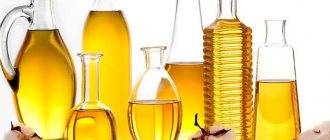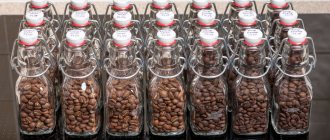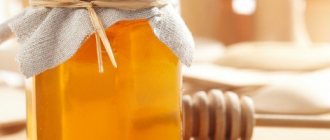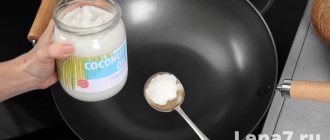How to choose the right honey storage container
To keep the “gift of bees” fresh and healthy for a long time, you need to choose a special container.
Clay pots or any other container are great for storing honey for a long time. A distinctive advantage is that it does not allow sunlight to enter, and prevents the penetration of third-party aromas and moisture. It is no coincidence that our ancestors chose and preferred clay utensils for these purposes.
- Plastic box
. Most manufacturers choose plastic only because it is lightweight and easy to transport. However, if it has an unpleasant odor, it is better to avoid using it at home. The container must be marked with special signs: PP, PP or “5”, which confirm their safety and stability. - Glass jars
are convenient and safe for storing fresh honey. The glass material itself does not react with the substances contained in them, and therefore does not emit unpleasant and dangerous substances and toxins. The only negative is the ability to transmit sunlight. A dark-colored container will do. The disadvantage of such dishes is fragility and high cost. - Wooden utensils
can influence the organoleptic properties, give it a truly excellent aroma, while preserving all the microelements and features. However, you need to take a close look at the choice of container. The best option is dishes made of birch, linden, and beech. You should not take containers made from wood species that emit essential oils (conifers, for example). - A metal container
is not a very suitable alternative. The thing is that the metal oxidizes over time, which negatively affects the properties, and after consumption, the health and well-being of people who can become poisoned. In this case, you need to choose the right metal utensils. An excellent option is containers that do not contain zinc, copper and lead.
How to choose a container for honey
How long the unique properties will appear depends on the conditions under which the bee product is kept. Natural sweetness will retain its medicinal qualities for several years if you place it in a dark corner, dry and cool, away from objects with a strong odor. An amber liquid in a jar left in the sun will lose its benefits in a matter of hours.
The packaging in which the treat is located is of no small importance. What container to choose for honey to preserve this valuable product healthy?
Requirements for honey storage containers
Durability, reliability and capacity come first when it comes to transporting large quantities. If we talk about retail sales, then in addition to these characteristics, it is important to provide branded packaging. You can order a product label on the website https://termoflexug.ru/production/etiketki-dlya-produktov/etiketki-dlya-myoda/
What requirements does an ideal honey container meet? The same conditions apply to various types of packaging: cleanliness and dryness, absence of strong odors. Barrels, pots and jars must be tightly closed. It is important to maintain a tight seal, otherwise the product will begin to absorb foreign odors and moisture, ferment and deteriorate.
It is allowed to use previously used containers. They are pre-washed, thoroughly rinsed with water and dried well. As a cleaning agent, preference is given to solutions of laundry soap or baking soda. You cannot add fresh delicacy to the remains of last year’s harvest: this also provokes the fermentation process and leads to spoilage.
Plastic
Inexpensive, lightweight and practical plastic packaging is becoming increasingly popular. A high-quality type of material that meets safety standards is used to store food products. Plastic containers for honey must be durable and strong enough: the product is heavy, and thin material may not withstand the load and crack.
It’s easy to transport even small plastic buckets: they fit tightly and securely and are equipped with handles for carrying.
A new type of packaging—cube containers—has gained the trust of wholesalers. Economical, lightweight, spacious and hermetically sealed boxes made of food-grade polyethylene are compactly stored and easy to clean. The volume of standard options is 12 and 23 liters.
The advantages of plastic during transportation and sale are obvious. It is difficult to say whether it is possible to store honey in plastic containers; there is no consensus here. Manufacturers of cube containers and plastic buckets give a positive answer, without specifying a specific time frame.
Connoisseurs are skeptical about this idea, believing that storing honey in plastic containers is not an ideal option. They suggest storing bee products in such a container for no more than 1 year. Natural dessert belongs to biologically active substances - you should not test for yourself how inert a particular package is.
Glass
An ordinary glass jar is a traditional, time-tested option. Glass does not enter into a chemical reaction, preserving the valuable qualities of amber sweetness. The optimal method for home storage has one drawback: fragile containers require careful handling and are easy to break.
If the glass is transparent, the honey stock is placed in a dark place, covered with dark paper or cloth, protecting it from exposure to light. The ideal option is a dark glass jar with a metal screw cap. Carriers do not favor fragile material: transporting goods in it is expensive and troublesome.
Ceramics
Clay and ceramic pots are also proven and affordable ways to store bee products. Clay dishes have a porous structure, which helps maintain the required temperature conditions. Pots made of this material do not allow sunlight to pass through, which has a detrimental effect on the healing qualities of the delicacy. The list of disadvantages is the same as that of glass: fragility, decent weight, high cost.
Wood and birch bark
The most expensive packaging is birch bark, which preserves the valuable qualities of the natural delicacy and looks aesthetically pleasing. Light, elegant tuyeskis attract attention and are often bought as gifts.
Wooden containers are not as expensive as birch bark containers, but they also belong to the group of expensive materials. Not every type of tree is suitable for storing bee products. The best option is barrels made of linden, birch and alder. Well-dried wood is used to make packaging. A container made of raw material dries out and allows leakage.
What to store
In nature, the best container for storing honey is a honeycomb. Bees securely seal frames with mature honey with wax. In this form it can be stored for a very long time without losing its beneficial properties. Beekeepers put the sealed frames away in boxes or empty hives, where the viscous amber liquid awaits its fate.
What to store
By purchasing honey in combs, the consumer is more likely to buy a natural beekeeping product. Wax honeycombs are not only a perfect vessel for honey, but also a very useful product that can be consumed along with the contents.
The honey in the combs is thoroughly chewed, spitting out the remaining wax. Natural wax helps strengthen tooth enamel, has an antimicrobial effect on the oral cavity and whitens teeth.
On a note! It is not advisable to keep honey in honeycombs at home. The wax shell does not prevent the absorption of odors, and if the wax seals are mechanically injured at room temperature, honey begins to flow. For preservation, it is better to seal comb honey in an airtight container.
Experts have different opinions regarding the material of the honey storage container. The palm was shared by:
- Ceramic dishes for storing honey.
- Glass jars.
- Food plastic containers.
- Wooden tueski.
Ceramic tableware
It has been used to store honey for thousands of years. A glazed clay pot is an ideal container for beekeeping products. The walls of the vessel do not allow sunlight to pass through, and the porous natural material maintains the required temperature and humidity inside. The only requirement is a tight fit of the lid, which is sealed with an elastic band or filled with wax.
Important! The disadvantage of ceramics is its high price, significant weight and fragility. Modern honey pots are designed not only for storing honey, but also for table decoration, as an original detail of the home interior.
Glass jars
A glass jar is the most common and frequently used container for packaging liquid honey. Glass does not react with biologically active honey mass. Honey can retain its beneficial properties in glass for a very long time, if the lid is securely sealed. The main disadvantage of glass is its fragility and weight. The transparent walls of the jar allow you to clearly see the product, but let the sun's rays through. Therefore, honey in glass is wrapped in paper or put away in a cabinet.
On a note
Particular attention should be paid to the lid. If a glass jar of honey is closed with a nylon or plastic lid, the shelf life is reduced and the product may lose its aroma.
Glass jars
Food plastic containers
Plastic is a cheap and convenient alternative to glass and ceramics. Required conditions:
- Labeling for food products (picture - glass and fork).
- Manufacturing material – polypropylene (markings: PP, PP, “5”).
It is desirable that the plastic container is opaque and not heated by sunlight or household appliances.
Interesting! How long honey can be stored at room temperature in a plastic container depends on the tightness of the lid and the location of the container. Experts do not recommend storing honey in plastic for more than 1 year.
Wood and birch bark
Since ancient times, honey was stored in birch bark tueskas and wooden barrels. Natural materials are well suited for storing medicinal products, but their cost is very high. In addition, wooden barrels and tubs made of “fragrant” conifers and oak (which gives a color tint) cannot be used as containers for honey.
Metal containers
Metal containers are not recommended for storing honey. The product contains active substances that react with metal. The acids contained in the honey mass corrode aluminum, copper and galvanized utensils, forming compounds hazardous to human health.
For your information. Metal utensils with an enamel coating and made of stainless steel are not dangerous.
Is it possible to choose plastic containers?
Plastic dishes are used in almost every family, including for storage. The industry produces a variety of containers in which it is so convenient to store cereals, sugar, frozen berries and vegetables. But are plastic containers suitable for storing honey? Will honey react with plastic if it is in contact for a long time?
Storing not only honey, but any food products in plastic containers that were originally intended for some other purpose, and then they were washed and, due to illiteracy or dishonesty, adapted for storing food products is hazardous to health. For example, cans of powdered chemicals and detergents can be reused. That is, you still have a wonderful container of dishwasher tablets, and you decide to wash it thoroughly and store honey in it. Is it dangerous!
In general, any plastic contains substances hazardous to humans, but, as a rule, they are released during combustion. Containers for products are made from plastics that do not fragment, do not disintegrate, or release hazardous components over a fairly wide temperature range. Products made from such plastic are sold together with other utensils, usually marked “For food purposes”, as well as engraved in the form of a triangle, inside of which one of the following numbers is visible: 1, 2, 4 or 6. This symbol is, in fact, not for the buyer, but for those who will have to dispose of this plastic. But it can be determined that the composition and quality of the plastic allows it to come into contact with food. Other numbers mark technical materials.
- Cookware marked 6 cannot be used for hot foods. One of the most dangerous materials. It is better not to use it for food products at all.
- With mark 5 - you can heat it in the microwave, pour tea and coffee into it.
- 4 - cling film is often made from it; in general, it is not so toxic.
- Marked 3 - hazardous when burning.
- 2 - usually used to make dense bottles, can be recycled.
- 1 - produce disposable cups and bottles for mineral water. Reuse is dangerous.
As you can see, there is nothing good about plastic dishes. That is, you can store honey in plastic containers for a short period of time, but it is better to choose safe containers.
Freezing rules
In order for the berries to retain maximum nutrients, as well as an attractive appearance and taste, you should follow the basic rules of freezing:
- Only ripe berries without signs of spoilage or rotting are frozen. You cannot freeze overripe berries; they will not retain their integrity and will turn into a shapeless mass when defrosted.
- Before freezing, the berries are cleared of leaves and stems.
- For freezing, it is advisable to use fresh berries that were picked a few hours ago. The fresher the berries, the higher the likelihood of retaining most of the nutrients they contain.
- Berries can be frozen not only whole, but also in the form of puree. To do this, washed and dried berries are crushed using a blender, and granulated sugar is added if desired.
- You can freeze each type of berry separately, or make a mix of different types.
How to freeze each type of berry:
- Remove the stems from ripe but not overripe strawberries. Freeze each berry as a puree or separately. Strawberries keep well, sprinkled with granulated sugar (for 1 kg of strawberries you will need 150 grams of sugar).
- It is also advisable to sprinkle raspberries with sugar before freezing (for 1 kg of raspberries, take 300 grams of granulated sugar).
- Gooseberries, black and red currants, blackberries, blueberries should first be cleared of twigs and leaves. You can freeze it as a puree or separately as berries.
- Sweet cherries and sour cherries are frozen with pits, but the pits can be removed before freezing. Housewives often make cherry puree, which, after defrosting, is added to compotes, casseroles, and used as a filling for pies.
- The most unpretentious berry to freeze is cranberries. In villages, cranberries are stored in the fresh air until frost sets in. In urban conditions, the berries can be kept on the balcony, and then, after removing excess moisture, placed in the freezer. Even at low temperatures, cranberries retain all their beneficial substances and can be stored for quite a long time.
American scientists have proven that blueberries and blueberries are much healthier for the human body if used after defrosting. The fact is that beneficial antioxidants are found in the peel of the berries, which is practically not absorbed if you eat fresh berries. In defrosted berries, the peel becomes more tender, and a useful complex of vital substances penetrates the human body.
Which berries are best not to freeze:
- Strawberry. If you do not follow the freezing rules, the strawberries will turn into a heterogeneous mass after defrosting. If you want to freeze strawberries, it is better to grind them with sugar or sprinkle with granulated sugar.
- Watermelon. The giant berry, as you know, consists almost entirely of water, so the watermelon pulp is not frozen. Watermelon will completely lose its taste and aromatic qualities, and in addition, consuming frozen pulp will negatively affect the state of the digestive system.
- Exotic berries and fruits. Fruits brought from overseas countries contain a large amount of harmful substances that help preserve their appearance during transportation. During defrosting, harmful substances are activated and can cause significant harm to human health.
If you follow the basic rules of freezing and use suitable containers, in the autumn-winter period you can treat yourself and your family with healthy dishes with the addition of frozen berries and fruits. Do not deny yourself the pleasure of eating juicy berries when it is drizzling or snowing outside the window. Spend a little time freezing summer berries, because this does not require special knowledge or skills. And you will stock up on vitamins for many months to come!
Food grade plastic
Food grade plastic is the most popular and most controversial container. There are many rumors that it is strictly forbidden to buy and store honey in plastic, because “poisons and toxins” will penetrate into the honey or the honey will very quickly lose its beneficial properties.
In fact, packaging for honey, if it is made of food-grade plastic, is the most convenient and safe container. It will fully preserve the benefits and quality of honey for the entire allotted storage period and even longer.
The plastic jar in which honey is packaged must have a fork and spoon icon. This symbol means that this jar is suitable for packaging food products and complies with current legislation.
Next to the fork and spoon icon there is a number - the plastic recycling class. For food grade plastic, which is made of polypropylene, this is 5. Such jars can then be taken to a waste disposal point so as not to pollute the environment and can be reused.
Another advantage of plastic packaging is that it does not require washing before use. Neither legally nor in fact. Plastic jars are well stacked, packed into boxes at the packaging manufacturer, wrapped in several protective layers of cellophane and arrive at the honey packaging workshop in a perfectly sterile condition.
Due to this, there is a significant saving in working capital for the honey producer, which is reflected in its price, and also reduces the risk of “unwashed” containers.
The next advantage of food-grade plastic is the light weight of the jar. So, a plastic jar of 250 ml (350 grams of net honey) weighs 30 grams with a lid, and its glass “colleague” will weigh 150 grams.
The weight of a glass jar, as well as the need to wash it before use, usually increases the cost of honey by 30-40%.
What determines the shelf life of honey?
Temperature
The main thing when saving is to maintain a temperature regime in the range from +1 to +20 C, according to the DSTU standard, a maximum of +25 C. Different types of honey are preserved under different conditions:
| Honey variety | Optimal temperature | Storage | Peculiarities |
| Linden/Floral | from -5 to +20 | Refrigerator / Kitchen cabinet / Freezer | Does not lose properties and taste when frozen. Doesn't crystallize for a long time. After settling, it can be stored indoors up to +30 C. |
| Rapeseed | from 0 to +5 | Refrigerator cabinet | Sugars quickly. Keep it cold only. |
| In the honeycomb | -5 to + 5 | Refrigerator/freezer/cellar | Doesn't like temperature changes. |
| With royal jelly | from 0 to +5 | Refrigerator/cellar | The addition of royal jelly reduces the shelf life to 6 months. |
| With propolis | from 0 to +20 | Refrigerator/cellar/kitchen cabinet | Not afraid of temperature changes. Retains elasticity for a long time. |
| With pollen | from 0 to +20 | Refrigerator/cellar/kitchen cabinet | If the temperature is maintained, it can be stored for up to 5 years. |
| With beebread | from 0 to +20 | Kitchen cabinet/ Refrigerator | Bee bread mixed with honey can be stored for about 1 year and is undemanding to conditions. |
It should be remembered why nectar from the apiary should not be heated too much: this leads to the loss of vitamins and microelements. The product darkens and a bitter taste appears.
Humidity
High humidity in the room will inevitably lead to souring of the miracle delicacy. Less is better. Ideally, the humidity level during storage will be 40–75%. The worse the packaging, and the lower the temperature, the lower the ambient humidity should be.
Capacity
First of all, the container must be lightproof and hermetically sealed. Ideally stored in earthenware or dark glass jars, it is allowed in wooden tubs and barrels. Beekeeping elements absorb the smell of wood, so you should avoid containers made of coniferous materials. For short-term storage or transportation, you can use a plastic container or bottle. But such containers are not intended for long-term preservation, since they transmit harmful sun rays, over time react with the contents and begin to release toxic substances. And it is no longer safe to eat it.
Also, you should not leave sweets in a metal container for a long time, as the oxidation process occurs, and life-threatening oxides get into your favorite treat.
Tightness
As mentioned above, any container with beekeeping elements must be hermetically sealed. As a result of improper storage, honey separates and begins to ferment. To avoid this, carefully monitor the tightness of the container. It’s best to purchase a set of special jars with hermetically sealed lids.
Odors and dust
Honey easily absorbs flour and cement dust, the smell of smoke and any chemicals. You should keep sweets away from strong-smelling foods. Unless, of course, you want to give your favorite sweet the specific smell of pickles or sauerkraut, for example.
Lighting
Exposure to sunlight in this case is destructive: it leads to the loss of all beneficial and healing properties. If you leave the jar on the windowsill, then within a day your healthy sweetness will turn into liquid sugar.
How and where to store it correctly
The place where honey is stored must have special conditions. For example, it does not tolerate sunlight, since it will heat the jar, and this will lead to the destruction of beneficial substances in it, including the enzyme inhibin, which is responsible for the antimicrobial properties of this product. Therefore, the best place to store honey is in a cellar or basement, if the humidity level is suitable.
There is no difference in how to store linden honey and rapeseed honey. But honey with beebread needs to be stored a little differently.
For example, in order to maximize the shelf life of beebread, you need to dilute it with honey in a ratio of 1:2 and send it to a dark, cool room with a humidity level of not 15%. But it’s worth dwelling separately on the temperature and containers where to store honey.
Watch the video about the secret of long-term storage of honey:
How to store honey in honeycombs
How to store honey in combs Many people prefer to buy honey in combs.
Of course, such a product is much healthier, but it requires special storage conditions. Therefore, it is very important today to know how to store honey in honeycombs. First of all, it should be said that natural “packaging” will not allow honey to crystallize for a whole year. But unsuitable humidity can affect it. So, before storing comb honey in a certain place, it is necessary to determine the degree of humidity in it.
If its level exceeds 60%, then the honeycomb may become limp, and if it drops below optimal, moths or mold may appear. The temperature is also important, which should be kept in the range from 3 to 10 degrees above zero.
This is interesting: 16 important tips - how you can and cannot process honey
For those who do not know in what conditions to store honey, it is also necessary to understand that you cannot put fruits or vegetables near it, especially bananas, and especially harmful chemicals, since it easily absorbs third-party aromas.
Watch a video on how to properly store centrifugal and comb honey:
Is honey stored in the refrigerator?
Many people are concerned about whether honey is stored in the refrigerator.
In principle, honey can be stored in the refrigerator if you follow a few rules. So, this is quite acceptable if the temperature in the refrigerator is not lower than 5 degrees Celsius (as a rule, this temperature regime is observed on the door). You can also store honey in the refrigerator if it has a dry freezing function, otherwise you will have to check the humidity level in it and, if necessary, remove excess moisture from the walls.
Attention!
Before placing honey in the refrigerator, you should make sure that the container in which it is located is sealed so that no foreign odors get inside.
Shelf life of honey in the refrigerator
It is not possible to indicate the exact period during which honey at home can be kept in the refrigerator without affecting its quality. This is due to the fact that the exact period of time a product retains its original properties is determined by the following factors:
- humidity indicator;
- type of honey;
- temperature conditions.
There are several rules, if followed, it is possible to extend the shelf life and preserve the maximum beneficial properties of honey. Basic recommendations, if followed, the product can be well stored in the refrigerator for a long time:
- Temperature changes negatively affect the quality, so it is not advisable to frequently remove the jar from the refrigerator.
- When a significant volume of product is stored, it is necessary to pour it into small containers, which will not only avoid taking out the main volume from the refrigerator each time, but also keep it in a liquid state longer.
- It is recommended to keep honey in tightly closed jars or other containers - this will preserve the taste characteristics and prevent the product from absorbing foreign flavors and odors.
Following these recommendations allows you to extend the storage period and at the same time help preserve viscosity, preventing the premature appearance of a white layer on the surface. Following these rules does not allow honey to lose its beneficial properties.
Where is it better to store honey: choosing between a refrigerator and a cabinet
To select a storage location, you need to know the temperature range at which honey does not lose its valuable properties: from minus 5 to plus 40 degrees Celsius. This interval is natural for bees; this is the temperature in the hives.
At home, honey should not be stored in winter on the balcony, in an unheated barn, in freezers, or near heating radiators, next to stoves and fireplaces, or in direct sunlight. All other locations are acceptable.
It is better, of course, to choose a dark place with a constant temperature and a minimum concentration of foreign odors. This could be a cabinet or refrigerator with a temperature of about 0 degrees, where there are no loosely closed containers with fish, sauerkraut, or marinades. The main thing is that the temperature does not fall below minus 5 degrees and, if possible, be constant. The last condition is well met in refrigerators with dry freezing (“No Frost”).
Can alcohol be stored in plastic containers for a long time?
I will say unequivocally - it is impossible. I will explain my point of view using a life example. This was back in the wonderful Soviet times: when breadfruit trees grew along the outskirts of the roads, and alcohol was issued with coupons. I then worked as an artist in a cultural center and, as a creative person, loved to get drunk. And somehow, on New Year’s Eve, our deputy director mixed up a ten-liter plastic canister of alcohol and called me to brag about his luck. So that’s why I’m telling all this - in two days the alcohol from that canister disappeared. There wasn’t even anything to get over the hangover with. By the way, it also evaporates from two hundred liter iron barrels, although not so quickly - it’s been tested.
It seems like alcohol producing factories claim that it is possible if it is bottled from them. There is large quantities of beer in plastic, I even bought vodka in Germany in a plastic bottle (Smirnovskaya). And the distillery is not far away; they often carry alcohol in plastic canisters. I won’t say anything about the release of harmful substances; these disputes will continue for a long time. But still, if there is talk, then it makes sense to think about it.
The period for which vodka can be stored in a glass bottle is virtually unlimited. But this condition applies exclusively to vodka without additional components. In particular, the shelf life of any vodka tincture usually does not exceed one year, and to guarantee the preservation of taste - no more than six months.
How to store honey: plastic, glass, wooden barrels?
What container should you store honey in: plastic, glass, wooden barrels?
Previously, glass containers were mainly used to store honey. Manufacturers and sellers poured it into glass from an aluminum flask, often right in front of customers, on the street, and no one was embarrassed.
Today, the honey market offers several packaging options, and now we will look at each of them in detail.
Food grade plastic
Food grade plastic is the most popular and most controversial container. There are many rumors that it is strictly forbidden to buy and store honey in plastic, because “poisons and toxins” will penetrate into the honey or the honey will very quickly lose its beneficial properties.
In fact, packaging for honey, if it is made of food-grade plastic, is the most convenient and safe container. It will fully preserve the benefits and quality of honey for the entire allotted storage period and even longer.
The plastic jar in which honey is packaged must have a fork and spoon icon. This symbol means that this jar is suitable for packaging food products and complies with current legislation.
Next to the fork and spoon icon there is a number - the plastic recycling class. For food grade plastic, which is made of polypropylene, this is 5. Such jars can then be taken to a waste disposal point so as not to pollute the environment and can be reused.
Another advantage of plastic packaging is that it does not require washing before use. Neither legally nor in fact. Plastic jars are well stacked, packed into boxes at the packaging manufacturer, wrapped in several protective layers of cellophane and arrive at the honey packaging workshop in a perfectly sterile condition.
Due to this, there is a significant saving in working capital for the honey producer, which is reflected in its price, and also reduces the risk of “unwashed” containers.
The next advantage of food-grade plastic is the light weight of the jar. So, a plastic jar of 250 ml (350 grams of net honey) weighs 30 grams with a lid, and its glass “colleague” will weigh 150 grams.
The weight of a glass jar, as well as the need to wash it before use, usually increases the cost of honey by 30-40%.
Glass
A glass jar, in some cases, has its advantages. So glass, especially dark glass, does not transmit ultraviolet rays. In production conditions and on the store shelf, this advantage, of course, is not significant, but if you buy honey pre-packaged by a beekeeper or seller in the open air - in a tent without an awning near the metro or on hiking trails, then you should make a choice in favor of glass.
In a store environment, honey does not need additional protection from ultraviolet radiation and buying it in dark glass or frosted plastic does not make sense. On the contrary, it is better to see the product in person. Although, it is more pleasant to give honey as a gift in a transparent glass jar; it favorably sets off the color of the honey and has a fascinating shine.
Wooden barrels or natural wax containers
Legal requirements also apply to these types of packaging - the inside of the barrel must be covered with a material suitable for contact with food. For honey, the more inert and airtight the packaging, the better.
Containers made entirely of wood or wax cannot meet these conditions. Therefore, if you were given honey in such a container, and you are not going to eat it in a week or two, then it is better to transfer the honey to a plastic container or glass jar with an airtight lid.
Here are some more tips:
- Honey should be stored in a tightly closed jar, in a place protected from direct sunlight, at a temperature not exceeding + 20 °C.
- If you eat honey every day, then you can keep the bucket on the table, covering the product with a lid.
- The concepts of “storing honey” and “containing during active consumption of honey” should be distinguished. It is better to store honey in an airtight container (plastic or glass), and the vase or pot from which you eat honey can be clay with glaze, or a crystal vase with a not entirely airtight lid.
- You can store honey in enamel and tin containers only if it is suitable for storing and processing food products.
- If you are going on vacation in the summer, we recommend putting honey in the refrigerator. At temperatures from +2 to + 8 °C, honey is stored better than at +25 °C and above and does not flake.
We thank the Private Apiary of Yuri Kholtobin for the information provided and assistance in writing the article. In the next article, you will learn how to eat honey correctly, whether you need to adhere to the regime, why you should drink water with honey on an empty stomach, and whether you can put honey in hot tea.
Subtleties and features of the storage process
But a product such as honey must be stored correctly.
The main condition that affects the quality and beneficial properties of honey is temperature.
It is best to store honey at a temperature from -5C° to +20C°.
Advice!
It is not advisable to overheat honey. When heated above +40 C°, honey loses some of its enzymes and vitamins and becomes simply a sweet treat. Cooling honey affects its quality to a much lesser extent than heating it.
Frequent changes in honey storage temperature can lead to uneven crystallization.
Another important condition for storing honey is the container. Since honey is hydroscopic, it actively absorbs moisture from the environment. This leads to an increase in the mass fraction of water in honey, its fermentation and spoilage. Therefore, honey must be stored in a tightly closed container.
The best way to store honey is in tightly closed glass containers or willow barrels (conifers, oak, etc. are absolutely not suitable for storing honey).
Honey can be stored in clay, enamel or plastic containers, but it is important to remember that untreated clay absorbs moisture, and plastic may not be resistant to the somewhat aggressive composition of honey (you can only use plastic containers for food), iron containers can also react with incoming substances included in honey.
It is strictly forbidden to store honey in galvanized and copper containers, as honey will react with them and may become toxic. It is important to remember that sunlight is extremely destructive to honey - it loses vitamins and enzymes, while maintaining taste and color.
Ideal storage conditions for honey: a cool, dark place in a tightly sealed glass container.
Shelf life of honey
Typically, manufacturers indicate on the packaging the shelf life according to GOST (GOST 19792-2001 “Natural Honey” and GOST R 52451-2005 “Monofloral Honey”) - 1 year. But this does not mean that after a year, honey becomes unsuitable for consumption.
Attention!
The shelf life of natural honey is unlimited, subject to storage conditions. Due to its preservative properties, natural honey retains its taste and beneficial properties for a very long time.
Some experts believe that over time, if stored properly, the taste of honey becomes even better and the aroma becomes more subtle due to the ripening process of honey. It is known, for example, that monks in Rus' preferred aged honey 2-3 years old.
And in the hives of wild bees, honey is stored for years and the age of a bee colony can be recognized by the color of mature honey, like the rings on a tree.
source: www.berestoff.ru
Storage containers
Honey is stored only in spotlessly clean containers made of glass or aluminum. You cannot pour honey into an uncleaned container under the pretext that honey was stored in it. The film of old honey promotes the fermentation of new honey, as a result of which the taste and smell of honey change.
Honey should not be stored in containers made of zinc, copper, lead or alloys of these metals, since under the influence of the acids contained in honey, chemical compounds are formed that can cause severe poisoning.
Iron containers are also contraindicated, since due to corrosion of iron as a result of prolonged contact with acids in honey, it acquires an unpleasant taste and smell.
Jars of honey should not be kept together with strong-smelling products (paints, fuel, essences), as honey quickly absorbs odors. An open vessel with honey should not be placed next to hygroscopic substances that help maintain humidity in the air (salt), as this causes accelerated fermentation of honey.
Honey packaged in glass jars should be stored in dark rooms, as light causes the quality of honey to deteriorate. Honey turns dark quickly. To liquefy crystallized honey, the vessel with honey is kept in hot water, in no case directly on fire.
Attention!
We only need to heat the amount of honey we need. Heated honey quickly begins to ferment and its quality deteriorates.
The presence of nutritional and medicinal properties in honey depends on its correct storage. It is known that in honeycombs and under certain conditions, honey can retain its nutritional properties for centuries. But for medicinal purposes, only fresh honey is desirable, or at least honey with a shelf life of no more than one year.
Honey, especially honeydew, is hygroscopic: it has the ability to absorb moisture from the air and retain it. If stored improperly in conditions of high humidity and in unsealed containers, honey can absorb up to 30% moisture. Such honey, if stored for a long time in a warm place and at a relative humidity of more than 60%, can ferment and sour.
Honey with a water content of 17.4% at the same air humidity does not exhibit hygroscopicity. Therefore, veterinary and sanitary rules provide for the storage of honey in a clean, dry, cool, well-ventilated room with a relative air humidity of 60% (at a temperature of no more than 20 ° C, if the honey moisture content is less than 21%; at a temperature not higher than 10 C, if the honey moisture content is more than 21 %) and always in the dark, since sunlight, direct sunlight and even scattered light have a detrimental effect on the antimicrobial properties of honey.
48 hours of continuous exposure of honey to sunlight completely destroys some enzymes, in particular the enzyme inhibin. Namely, this enzyme is credited with antimicrobial properties. Therefore, you need to be especially careful when storing and preparing honey for sale.
The honey storage room must be isolated from toxic, dusty substances that have a sharp specific odor, since honey easily absorbs flour and cement dust, foreign odors from strong-smelling products such as fish, pickles, cheeses, sauerkraut.
Honey easily absorbs the smell of smoke, gasoline, kerosene, turpentine, pesticides, etc. The room where honey is stored is protected from insects entering it.
This is interesting: 12 tips on how to choose the right honey when buying at the market or in a store
At home, it is advisable to store honey in a cellar or refrigerator. Honey can be stored at sub-zero temperatures (down to -20 °C). The healing properties of honey are not lost.
It is important!
As a rule, almost all natural honeys are in a crystallized state in autumn and winter. If honey is liquid in winter, this indicates that it has been adulterated or has been overheated.
Two layers of honey During the storage of honey, sometimes two layers are formed - crystallized at the bottom and syrup-like at the top - this indicates the immaturity of the honey, its high humidity, but not always. So, if grape sugar - glucose - is contained in honey (even mature) in small quantities, then during crystallization it settles to the bottom, and fruit sugar - fructose - above it. After mixing, such honey is allowed for sale.
For storing honey, the most hygienic and convenient are glass, enamel or nickel-plated containers with thick plastic or metal lids:
- wooden barrels (barrels) made of beech, birch, willow, cedar, linden, plane tree, aspen, alder with wood moisture content not exceeding 16%, that is, below the permissible moisture content of honey. Barrels made of coniferous trees are not suitable, since honey acquires resin during storage; You can’t store it in oak barrels: honey darkens;
- milk cans and flasks made of stainless steel, sheet steel, tinned with food grade tin, aluminum and aluminum alloys;
- tin cans coated inside with food varnish;
- glasses or tubes made of aluminum foil coated with food varnish;
- glass jars and other types of glass containers (to prevent glass jars from cracking, when filling them with liquid honey, wooden sticks are inserted, remaining until crystallization is complete);
- glasses molded or corrugated from pressed cardboard with moisture-proof impregnation;
- bags, cups and boxes made of waxed paper, parchment - for crystallized honey; from artificial polymeric materials, for food purposes;
- The dishes are ceramic, coated on the inside with glaze. The container must be clean, odorless, hermetically sealed. It is allowed to use rubber gaskets.
It is contraindicated, and even dangerous, to store honey in galvanized and iron containers, as this creates toxic substances. When honey is stored in a copper container, it turns bluish-green, and when stored in an iron container, it turns dark red. It is prohibited to store honey in containers made of synthetic materials.
It is important!
You cannot heat honey, as this destroys all the components of honey, the color changes - the honey darkens, the aroma disappears, bactericidal substances, vitamins, and enzymes are destroyed. This process is observed at normal storage temperatures, but accelerates at elevated temperatures. Partial decomposition of sugars occurs and hydroxymethylfurfural is formed.
As a result, honey loses its biological and many medicinal properties and becomes a simple mixture of nutrients, mainly carbohydrates.
Studies have shown that honey should not be heated at all, or even stored at temperatures above 20 °C.
Heating to a temperature of 35-40 °C is already unfavorable for it - complete deactivation of vitamins occurs, and starting at a temperature of 50 °C, honey quickly loses its bactericidal properties and aroma, 60 °C - enzymes, 80 °C - sugars are destroyed and a significant amount is formed hydroxymethylfurfural.
Prolonged heating of honey leads to almost complete loss of antimicrobial properties.
The low content of hydroxymethylfurfural is a valuable indicator of very careful and proper processing and storage of honey. Based on its content, it can be determined that the honey has been adulterated and artificial inverted sugar has been added to it.
When honey is stored for more than one year, its biological activity gradually weakens. For example, when honey is stored at a temperature of 23-28 C for 8-12 months, its antimicrobial properties, the amount of glucose and fructose decrease by 5-10%, vitamins BXi B2 and C by 10-20%, the diastase number drops almost by half, the amount of sucrose and acids increases. The higher the storage temperature of honey, the more significant the change in its properties.
Source: www.pchelovod.com
Freezing berries for the winter in plastic bottles
Of course, the most common way of preparing berries for the winter is jam and compotes, and all of this is of course delicious, but not for everyone, I prefer to freeze the berries, and then, if necessary, cook compotes or preserves from these berries, use them in baking, yes and just like that - defrost and enjoy.
Many who have tried to freeze berries have noted that over time the taste of such berries deteriorates, but there is a way out. Firstly, use plastic food containers or plastic bottles instead of plastic bags, and secondly, sprinkle the berries with sugar before freezing. Absolutely any berries are suitable for freezing in this way, the only problem being some cherries. which I plan to use in the future for baking, I remove the seeds in advance. In addition, you can freeze assorted berries this way.
Preparing berries for freezing.
The berries are thoroughly washed, the stalks are removed, only high-quality berries without spoilage are selected, then the selected berries are placed on a wire rack to give it time to dry from the water.
Preparing containers for freezing.
If you are using new food grade plastic containers or bottles, simply rinse them with baking soda and let them dry thoroughly.
If these are plastic bottles that previously contained juice or milk, then pay special attention to washing, especially if the bottles contained a dairy product. By the way, it’s not in vain that it was said about the dairy product - bottles for milk and fermented milk products have a wide neck and are much more convenient to use. Next is the process itself
Next is the process itself.
After the berry has dried, take a little berry, lightly sprinkle with sugar (to taste), mix and place in a bottle or plastic container, repeat the process until the container is full, you can use a wide-necked funnel to fill the bottle, We close it and put it in the freezer, I prefer to use bottles, since such a container closes more hermetically and the berries do not lose their taste and quality until the next harvest.
Why do we process the berries in small portions? - Everything is simple here, if there are a lot of berries and they are tender, such as raspberries, strawberries, then when mixing they can be mashed.
When the honey became sugary
Sugaring is a natural process and an indicator of quality. Crystallization does not change the nutritional and medicinal qualities of the product. The crystals can be of different sizes and inevitably appear 3-6 months after being removed from the honeycomb. Crystallization occurs due to the chemical composition of the product, the main components of which are glucose and fructose. The more glucose in honey, the faster it will sugar. For example, sunflower may begin to form crystals while still in the comb. Uneven crystallization is considered normal. High fructose honeys, such as chestnut or sage, do not crystallize as quickly as other honeys. Acacia can remain in a liquid state for the longest time.
Additional Information. Glucose in the product may produce a white film or spots of varying sizes on the surface, which is a good sign of natural ripe honey.
When layering a beekeeping product, an important factor is that its upper liquid part is not too watery, which may indicate a violation of pumping deadlines and poor quality of the product. Also, the reason when honey remains in a liquid state for more than six months may be that the heating temperature was exceeded during dissolution for packaging. There are no vitamins or medicinal microelements left in such a product.
The quality of the sweetness can be checked by dissolving the mass in water: the natural product completely dissolves within 10 minutes, leaving a cloudy yellowish solution.
To restore the fluidity of the candied product, melt a separate portion in a steam bath
If you want to restore the fluidity of the candied product, you should melt a separate portion in a steam bath. You should not melt the mixture over an open fire or allow it to boil, otherwise the honey will turn into a carbohydrate that has no medicinal properties. There is no need to melt large quantities for subsequent storage purposes; a heat-treated product is stored worse and loses its beneficial qualities faster.
Is it possible to eat honey that has crystallized in a plastic container?
The separation of honey into thick and liquid is a normal process during long-term storage.
It does not degrade the quality of the product and does not affect the usefulness and taste. Honey crystallization is a natural process of making the product natural. It is a sign of the quality of honey. No chemical reactions occur during crystallization. This process depends on certain conditions: temperature, humidity, storage duration, mechanical stress. The main components of honey are glucose and fructose. It is these substances that underlie the process. Glucose crystallizes, and fructose remains in a liquid state, surrounding the crystals. If honey contains more glucose, the crystallization process will begin earlier. This includes, for example, sunflower honey. If it contains more fructose, then there will be much fewer honey crystals, as, for example, in acacia honey.
The ratio of water and glucose also plays a huge role in this process. That is, if there is more water in honey than glucose, then it will remain liquid longer. Low temperature slows down the crystallization process, since the molecules move much more slowly than at higher temperatures. At high temperatures, large crystals form.
How to properly store honey so that the product does not spoil and retains its beneficial properties for a long time, watch our video:
If honey is stored for a long time, this also affects the crystallization process - over time, the concentration of glucose in honey decreases, and fructose begins to predominate. Accordingly, the honey becomes liquid again. Mechanical action destroys the formed crystals, which slows down and stops the crystallization process. If you add thick honey to liquid honey, the process will go much faster - the existing crystals will join the rest, and their mass will increase.
What determines the shelf life of vodka?
The shelf life of vodka, like any product, depends on certain conditions:
- from the composition;
- on storage and transportation conditions;
- from container.
Composition of the drink
When discussing the shelf life of vodka, you need to know its classification.
According to its composition, “white” is divided into simple and special:
- A simple
alcoholic drink is prepared from ethyl alcohol and specially prepared water (spring or purified). Some manufacturers add it to certain brands of product. This vodka is harder to drink, has a pronounced smell of alcohol, but lasts longer if it contains high-quality ingredients.
Vodka with the addition of components of plant origin: herbs, fruits, berries is called special This is done to give the drink softness and drown out the harsh “aroma”. Over time, the fillers enter into an oxidation reaction with alcohol, which renders the vodka unusable. This product must be used within six months, maximum 12 months from the date of manufacture.
High-quality vodka has a mild taste and a sweetish aftertaste; bitterness is unacceptable
Storage and transportation conditions
- keep indoors without exposure to sunlight;
- maintain storage temperature from -15 to +30 degrees;
- maintain indoor humidity at 85%;
- monitor the integrity and tightness of the packaging.
The shelf life of vodka directly depends on the conditions of transportation of the alcoholic beverage.
- Vodka, like any alcohol-containing liquid, does not tolerate temperature changes, so it is not transported in hot or cold weather. The optimal temperature is considered to be 11-12 degrees Celsius.
- If the journey takes several days, the cargo is placed in refrigerators or insulated vans.
- Enclosed transport is used to prevent sunlight from entering.
- To maintain the integrity of the packaging, care is taken to firmly strengthen the products.
Storage containers
If you pay attention to the containers in which the “transparent tear” is placed on store shelves, you can conclude that the most suitable for it are glass bottles of various capacities. And it is right. Do you know that…
Do you know that…
Alcohol is a chemical substance. It enters into an oxidation reaction with both vegetable fillers and containers.
There is often a debate among consumers about whether vodka can be stored in a plastic bottle.
- Ethyl alcohol actively interacts with this polymer, releasing toxic substances into the solution. When they enter the human body, they cause severe poisoning.
- For the same reason, you should not pour “white” into crystal or ceramic decanters, even for a short time.
Glass is least susceptible to change from exposure to alcoholic beverages
Tip of the day
Let's summarize
Storing honey is a responsible matter. Therefore, you should not treat it with disdain. Otherwise, the product can deteriorate in a record short period of time, and its further use will cause irreparable harm to the body. Based on all of the above, we can identify the main criteria that must be taken into account when storing the product.
Temperature
It is very important to store the product at the optimal temperature. Otherwise, it will begin to deteriorate and delaminate, losing its beneficial properties.
It should be noted that vitamins will evaporate instantly if the product is heated to +40 degrees. Too low a temperature causes hardening. Dishes. Can honey be stored in plastic containers? It's possible, but not for too long. However, the best option is a clay pot or glass jar. Do not place treats in iron or galvanized containers under any circumstances, so as not to spoil them. Humidity. The lower this indicator is, the better for the product. This circumstance is due to the fact that honey absorbs moisture at a rapid pace. To prevent this from happening, the storage container must be airtight. Light and smell. As already mentioned, direct sunlight kills the product. Therefore, you cannot store it on windowsills. It is best to place honey in a dark place where there are no chemicals or seasonings. There should be no other strong-smelling substances near the treat. Even the most airtight container is not able to completely protect honey from foreign odors.
How long can honey be stored in plastic containers and at what temperature?
If you plan to store honey in plastic containers, you must maintain the correct temperature conditions and ensure that the packaging is sealed.
The shelf life in plastic containers is limited, but this is not due to the characteristics of the packaging itself, but to the quality characteristics of the product. Provided that the container is sealed, protected from light and at a certain temperature, the shelf life can be up to 5 years.
The best conditions for storing honey are honeycombs. They retain their healing properties for up to 15 years. Subject to storage conditions in plastic containers, the quality of the product is guaranteed for 3 years. If the can is opened, air enters, and it is placed in direct sunlight, then such a product should be consumed as quickly as possible.
The storage temperature recommended for long-term storage should not exceed 15 °C. The best place for storage is the refrigerator. If the temperature exceeds 20 °C, the product begins to deteriorate and becomes bitter and dark.
This delicacy, like any product, has its own expiration date. It can be stored in a beehive indefinitely, as it is a food reserve for bees. There it is located in honeycombs that prevent various microorganisms from entering it. Once the cell is full, the bees seal it, which prevents oxygen from entering and further fermentation of the honey.
The best option is to store honey in honeycombs. This will preserve the sweet nectar and all its beneficial properties.
There are three forms of honey: in combs, liquid and thick. Each of them has its own shelf life. According to GOST, it does not exceed 1 year, but under the right conditions this period is several years. At home, honey is best stored in the form of honeycombs, since their composition includes wax, propolis and honeycomb. These substances retain the beneficial properties of honey. The shelf life in this form is 10–15 years.
Liquid honey thickens over time, this happens after more than 1 year or at temperatures below –20 ° C. The shelf life itself depends on other components, but there is one feature - if honey is collected in dry summer or late autumn, then such a product will not be stored for long. The best time to purchase delicacies is August-September. You need to purchase it at special fairs from beekeepers. May, acacia (floral) and linden are stored the longest. Store-bought honey is good for no more than 1 year.
